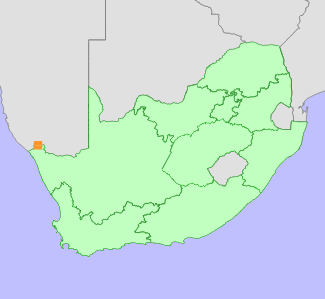|
Scientific Name | Eberlanzia schneideriana (A.Berger) H.E.K. Hartmann |
Higher Classification | Dicotyledons |
Family | AIZOACEAE |
Synonyms | Mesembryanthemum floriferum N.E.Br., Mesembryanthemum lacunatum N.E.Br., Mesembryanthemum rugulosum A.Berger ex Range, Mesembryanthemum schneiderianum A.Berger, Ruschia hallowayana L.Bolus, Ruschia hollowayana L.Bolus, Ruschia pillansii L.Bolus, Ruschia schneideriana (A.Berger) L.Bolus, Ruschia spathulata L.Bolus, Ruschia sphaerophylla Dinter, Ruschia velutina L.Bolus |
National Status |
Status and Criteria | Endangered A2ace+4ace |
Assessment Date | 2022/09/07 |
Assessor(s) | P.C.V. Van Wyk, N.A. Helme & D. Raimondo |
Justification | A restricted range species with an extent of occurrence (EOO) of between 1235 and 1900 km². At least half of this succulent habitat falls within areas that have already been mined or will be lost to mining over the next 20-30 years. The population is suspected to have declined by 50% since 1990 as a result of mining and mortality caused by drought, while some recovering following the drought is possible since this species can germinate with only small amounts of rainfall, ongoing aridification of its range coupled with ongoing loss to mining is projected to result in a further 10-15% of the population being lost by 2050 (generation length 20). It therefore qualifies for listing as Endangered under criterion A. Since the population in Namibia is also being impacted by both drought and mining the regional status for this species is not adjusted. |
Distribution |
Endemism | Not endemic to South Africa |
Provincial distribution | Northern Cape |
Range | This species is restricted to the Sperrgebiet region of Namibia and the northern parts of the Richterveld region of South Africa. |
Habitat and Ecology |
Major system | Terrestrial |
Major habitats | Desert |
Description | It grows in rocky areas. |
Threats |
| Many of the subpopulations within the South African portion of its range fall within the Lower Orange River mining licensed area where there is ongoing loss of habitat, and subpopulations as a result of mining activities. Mining activity also happens within its range in Namibia. Furthermore the population is declining due to climate change. Its entire range has experienced below-average rainfall since 2012. Predictions of future climate change include further increases in annual average temperature of between 1.4°C and 2.4°C by 2050, which will result in unbearably hot temperatures and ongoing aridification throughout significant portions of the year (Van Wilgen et al. 2017). Within South Africa it has also lost habitat to severe overgrazing by livestock between 2002 and 2014. |
Population |
Multiple subpopulations across this species range have been monitored over the past 10 years on the iNaturalist platform, between 15 and 20 subpopulations have been recorded many of these consisting of fewer than 50 individuals. At least 50% of the population falls within areas that have either already been lost to mining or are earmarked to be mined within the next 15 years. Five subpopulations were observed to have lost all plants in 2021 as a result of drought related mortality, and many others have also had high levels of mortality observed. Based on these observations we suspect that between 50 and 60% of the overall population has been lost over the past 32 years as a result of both mining and drought. Loss is predicted to be ongoing with a further 10-15% of the population likely to decline over the next 28 years.
|
Population trend | Decreasing |
Assessment History |
Taxon assessed |
Status and Criteria |
Citation/Red List version | | Eberlanzia schneideriana (A.Berger) H.E.K. Hartmann | Least Concern | Raimondo et al. (2009) | |
Bibliography |
Raimondo, D., von Staden, L., Foden, W., Victor, J.E., Helme, N.A., Turner, R.C., Kamundi, D.A. and Manyama, P.A. 2009. Red List of South African Plants. Strelitzia 25. South African National Biodiversity Institute, Pretoria.
Snijman, D.A. 2013. Plants of the Greater Cape Floristic Region 2: The extra Cape flora. Strelitzia 30. South African National Biodiversity Institute, Pretoria.
Van Wilgen, N.J. and Herbst, M. 2017. Taking stock of parks in a changing world: The SANParks Global Environmental Change Assessment. SANParks, Cape Town.
|
Citation |
| Van Wyk, P.C.V., Helme, N.A. & Raimondo, D. 2022. Eberlanzia schneideriana (A.Berger) H.E.K. Hartmann. National Assessment: Red List of South African Plants version 2024.1. Accessed on 2025/11/18 |
 Comment on this assessment
Comment on this assessment


